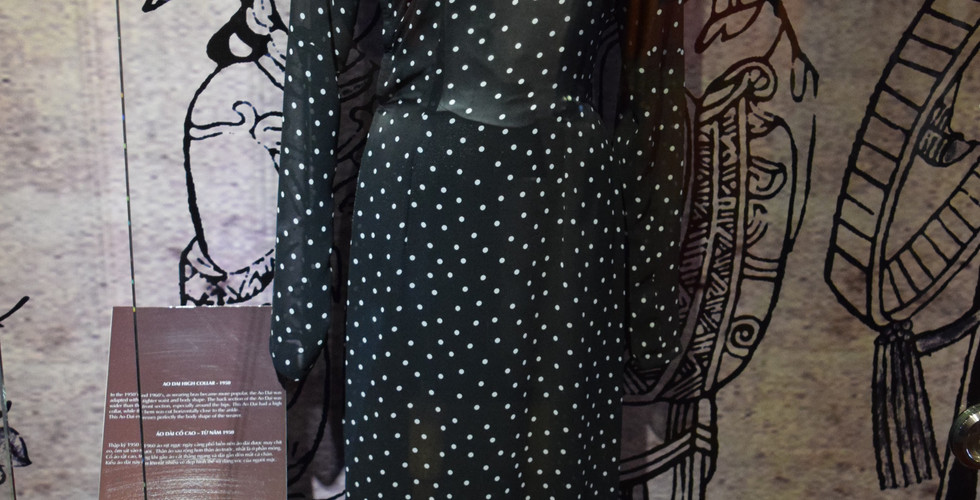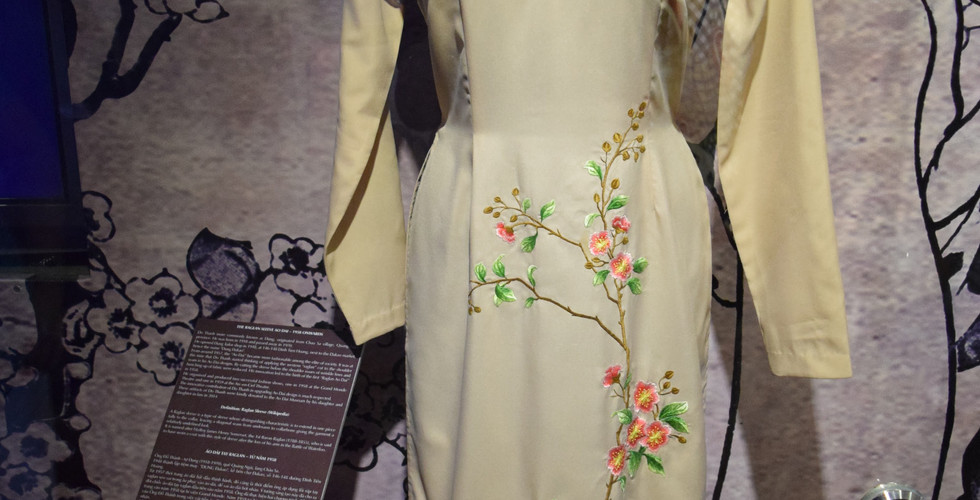The Evolution of the Áo Dài, National Costume of Vietnam
- Theresa Ngo
- Oct 17, 2016
- 4 min read
The áo dài is a piece of Vietnamese culture that symbolizes the history and beauty of our people. Its simple yet flattering silhouette has the ability to make a woman feel beautiful and elegant.
Over the summer, I had the chance to visit Vietnam and saw an áo Dài exhibit at the Bitexco Financial Tower in Ho Chi Minh City. I was immediately amazed and intrigued by all the different designs and how the dress has evolved over the course of Vietnam’s history.
So what exactly is an áo dài? Let’s break down the phrase. “Áo” means “shirt” in Vietnamese and “Dài” means “long”, therefore “áo dài” translates to “long shirt.” The áo dài is a long fitted tunic that is worn over trousers. This seems like a simple design, right? So how does such a simple outfit have such a large impact on not only Vietnamese fashion, but international fashion?
Áo Tứ Thân & Áo Ngũ Thân
During the 19th century, the áo tứ thân and áo ngũ thân became popular. These dresses were worn by women from northern Vietnam and are composed of multiple parts. Áo Tứ Thân has four separate pieces: Yếm (bodice), tunic, skirt, and belt. Áo Ngũ Thân, a variation of áo tứ thân that was mostly worn by wealthy women, is made of five pieces sewn together with the bottom portion of the dress separated into two panels, an element present in the modern áo dài.
Áo Dài
The áo dài was first introduced during the Nguyen Lords era and was required to be worn by all members of the court in order to make a distinction from their rivals, the Trinh Lords. The outfit consisted of a long, loosely fitted tunic and pants.
During the French colonization of Vietnam in the 1930’s, Vietnamese fashion became heavily influenced by western fashion, which led to one of the greatest breakthroughs of the áo dài’s design: the creation of the Le Mur áo dài. This design of the áo dài is named after its creator, artist Cát Tường (also known as Le Mur). Inspired by Parisian fashion and the áo Ngũ Thân (a dress worn by northern Vietnamese women), Cát Tường kept the two-panel element of the áo Ngũ Thân, cinched the waistline and added Western elements such as puffed sleeves and a bow. This design became a sensation not only with the Vietnamese people, but with everyone else around the world, which led to the áo dài being named Vietnam’s national costume.
Next came the addition of the raglan sleeves. A major issue with earlier versions of the áo dài was that they wrinkled very easily at the armpits. Not only did adding raglan sleeves to the áo dài reduce wrinkles, it also allowed for the áo dài to be more fitted to accentuate a woman’s curves and made it easier for the wearer to move their arms while wearing the dress.
In the early 1960’s, Madame Nhu, wife of politician Ngô Đình Nhu, designed the áo dài with a boat neck. This version of the dress became very controversial because it strayed away from the traditional design, which had a high-collared neck. Many saw it as too suggestive for a woman to wear, but today, the boat neck is very popular among áo dài wearers because it is more comfortable.
During the late 60’s to 70’s, the áo dài became women’s choice for everyday fashion. This led to several modifications of the dress. The dress was not as tightly fitted around the waist in order to allow the wearer to move more freely. Also, the length of the dress was shortened to just below the knee to help with convenience.
After the communist takeover in 1975, the áo dài was rarely seen on the streets due to the economic crisis and ongoing political issues. It wasn’t until the 1990’s when the áo dài became popular again. Schools adopted the áo dài as the uniform for girls and Miss áo dài pageants were held in order to preserve the áo dài. Áo dài’s today come in all shapes and sizes. Some designers add elements of high fashion to their designs and some integrate aspects from other cultures to their áo dài’s.
No matter what style a woman loves to sport on a day to day basis, when she puts on an áo dài, she can instantly feel elegant and graceful. But more importantly it makes a woman feel proud of her culture.
San Jose, California - Ao Dai Festival 2016
Ha Noi, Vietnam - Ao Dai Festival 2016
If you like stories like this, subscribe to Chopsticks Alley.

Theresa Ngo
Contributor
Theresa is currently a biology student at the University of San Francisco. She is interested in fashion and hopes to share her thoughts on the current fashion industry as well as Vietnamese involvement in the industry through her stories. As a Vietnamese-American, Theresa has a strong love for the Vietnamese culture and wants to contribute to its preservation for future generations here and abroad.






























Footwear and clothing are essential elements of personal style, reflecting individuality and cultural trends. From casual sneakers to elegant dresses, fashion choices speak volumes. Brands continuously innovate to meet consumer demands, blending comfort with aesthetics. For those seeking reliable recommendations, azzlee reviews offer valuable insights into the latest trends and quality products. Whether you're updating your wardrobe or investing in durable footwear, staying informed ensures smart purchases. As seasons change, so do fashion preferences, making it crucial to stay ahead. Embrace the fusion of functionality and style, and let azzlee reviews guide your next fashion statement.
Click here provide members with discounts on over-the-counter medications, vitamins, and health essentials, promoting better health management and cost-effective wellness solutions. kaiserotcbenefits.com - more details here
Click here help you find recent death notices, providing information about funeral services, memorials, and tributes for loved ones in your area. obituariesnearme.com - more details here
Click here? Many users have had mixed experiences with the platform, so it's important to read reviews and verify deals before booking. istravelurolegit.com - more details here
National dress represents the cultural heritage and identity of a country. It reflects history, traditions, and values passed down through generations. Whether it's a kilt in Scotland, a kimono in Japan, or a shalwar kameez in Pakistan, each attire holds deep significance. Proper tailoring ensures these outfits maintain their elegance, with services like trouser alterations playing a crucial role in achieving the perfect fit. Wearing national dress on special occasions fosters unity and pride, reminding people of their roots and the beauty of their traditions.
google 优化…
무료카지노 무료카지노;
Fortune Tiger…
Fortune Tiger…
Fortune Tiger…
Fortune Tiger…
gamesimes gamesimes;
站群/ 站群
03topgame 03topgame
betwin betwin;
777 777;
slots slots;
Fortune Tiger…
谷歌seo优化 谷歌SEO优化+外链发布+权重提升;
google 优化 seo技术+jingcheng-seo.com+秒收录;
Fortune Tiger Fortune Tiger;
Fortune Tiger Fortune Tiger;
Fortune Tiger Fortune Tiger;
Fortune Tiger Slots Fortune…
站群/ 站群
gamesimes gamesimes;
03topgame 03topgame
EPS Machine EPS Cutting…
EPS Machine EPS and…
EPP Machine EPP Shape…
Fortune Tiger Fortune Tiger;
EPS Machine EPS and…
betwin betwin;
777 777;
slots slots;
Fortune Tiger Fortune Tiger;